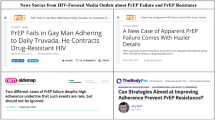Abstract
The purpose of this study was to investigate the hypothesis that human immunodeficiency virus (HIV) transmission may be facilitated or obstructed by network structure, incorporating a measure of risk that combines true risk and surrogates. Persons at presumed high risk for HIV were enrolled in long-term follow-up studies of urban and rural networks in Atlanta, Georgia, and Flagstaff, Arizona. We focused on respondents who were also contacts to evaluate information on both sides of the observed dyads and constructed a Risk Indicator, based on a four-digit binary number, that permitted assessment and visualization of the overall risk environment. We constructed graphs that provided visualization of the level of risk, the types of relationships, and the actual network. Although some of the findings conform to the hypotheses relating network structure to transmission, there were several anomalies. In Atlanta, HIV prevalence was most strongly related to men with a male sexual orientation, despite the widespread use of injectable drugs. In Flagstaff, an area of very low prevalence and no transmission, the risk environment appeared more intense, and the frequency of microstructures was as great or greater than representative areas in Atlanta. The network hypothesis is not yet sufficiently developed to account for empirical observations that demonstrate the presence of intense, interactive networks in the absence of transmission of HIV.
Similar content being viewed by others
References
Goodman SN. P values, hypothesis tests, and likelihood: implications for epidemiology of a neglected historical debate. Am J Epidemiol. 1993;137:485–496.
Greenland S. Randomization, statistics, and causal inference. Epidemiology. 1990;1: 421–429.
Feinstein AR. P-values and confidence intervals: two sides of the same unsatisfactory coin. J Clin Epidemiol. 1998;51(4):355–360.
Feinstein AR. Scientific standards in epidemiologic studies of the menace of daily life. Science. 1988;242:1257–1263.
Savitz DZ, Greenland S, Stolley PD, Kelsey JL. Scientific standards of criticism: a reaction to “Scientific standards in epidemiologic studies of the menace of daily life,” by A. R. Feinstein. Epidemiology. 1990;1:78–83.
Taubes G. Epidemiology faces its limits. Science. 1995;269:164–169.
Garnett GP, Anderson RM. Factors controlling the spread of HIV in heterosexual communities in developing countries: patterns of mixing between different age and sexual activity classes. Phil Trans R Soc Lond B. 1993;342:137–159.
Rothenberg RB. Model trains of thought. Sex Transm Dis. 1998;24:201–203.
Klovdahl AS. Social networks and the spread of infectious diseases: the AIDS example. Soc Sci Med. 1985;21(11):1203–1216.
Friedman SR, Neaigus A, Jose B, et al. Sociometric risk networks and risk for HIV infection. Am J Public Health. 1997;87:1289–1296.
Potterat JJ, Rothenberg RB, Muth SQ. Network structural dynamics and infectious disease propagation. Int J STD AIDS. 1999;10:182–185.
Potterat JJ, Phillips-Plummer L, Muth SQ, et al. Risk network structure in the early epidemic phase of HIV transmission in Colorado Springs. Sex Transm Infect. In press.
Potterat JJ, Muth SQ, Rothenberg RB, et al. Sexual network structure as indicator of epidemic phase. Sex Transm Infect. In press.
Rothenberg RB, Potterat JJ, Woodhouse DE, Muth SQ, Darrow WW, Klovdahl AS. Social network dynamics and HIV transmission. AIDS. 1998;12:1529–1536.
Rothenberg RB, Long D, Sterk C, et al. The Atlanta urban networks study: a blueprint for endemic transmission. AIDS. 2001;14:2191–2200.
Wylie JL, Jolly A. Patterns of chlamydia and gonorrhea infection in sexual networks in Manitoba, Canada. Sex Transm Dis. 2001;28(1):14–24.
Mastro TD, de Vincenzi I. Probabilities of sexual HIV-1 transmission. AIDS. 1996; 10(suppl A):S75-S82.
Royce RA, Sena A, Cates W, Cohen MS. Sexual transmission of HIV. N Engl J Med. 1997;336(15):1072–1078.
Vittinghoff E, Bucbinder SP, Judson F, Douglas JMD, MacQueen K. Per contact risk for transmission of HIV associated with four types of homosexual contact. Paper presented at: Fifth Conference on Retrovirus and Opportunistic Infections; February 1–5, 1998; Chicago, IL.
Borgatti SP, Everett M, Freeman L. Ucinet V for Windows: Software for Social Network Analysis. Natick, MA: Analytic Technologies; 1999.
Krackhardt D, Blythe J, McGrath C. Krackplot. Version 3.0. Pittsburgh, Pa: Analytic Technologies; 1995.
Garnett GP, Hughes JP, Anderson RM, et al. Sexual mixing patterns of patients attending sexually transmitted diseases clinics. Sex Transm Dis. 1996;23(3):248–257.
Gupta S, Anderson RM, May RM. Networks of sexual contacts: implications for the pattern of spread of HIV. AIDS. 1989;3:807–817.
Kretzschmar M, Morris M. Measures of concurrency in networks and the spread of infectious disease. Math Biosci. 1996;133:165–195.
Morris M, Kretzschmar M. Concurrent partnerships and the spread of HIV. AIDS. 1997;11:641–648.
Kretzschmar M. Sexual network structure and sexually transmitted disease prevention: a modeling perspective. Sex Transm Dis. 2000;27(10):627–635.
Anderson RM, Garnett GP. Mathematical models of the transmission and control of sexually transmitted diseases. Sex Transm Dis. 2001;27(10):636–643.
Service SK, Blower SM. HIV transmission in sexual networks: an empirical analysis. Proc R Soc London B. 1995;260:237–244.
Gladwell M. The Tipping Point: How Little Things Can Make a Big Difference. New York: Little Brown and Company; 2000.
Janssen R. Serostatus approach to fighting the HIV epidemic (SAFE): a new prevention strategy to reduce transmission. Paper presented at: Eighth Conference on Retroviruses and Opportunistic Infection: February 4, 2001; Chicago, IL.
DesJarlais DC, Friedman SR. HIV epidemiology and interventions among injecting drug users. Int J STD AIDS. 1996;7(suppl 2):57–61.
Patrick DM, Strathdee SA, Archibald CP, et al. Determinants of HIV seroconversion in injection drug users during a period of rising prevalence in Vancouver. Int J STD AIDS. 1997;8(7):437–445.
DesJarlais DC, Marmor M, Friedmann P, et al. HIV incidence among injection drug users in New York City, 1992–1997: evidence for a declining epidemic. Am J Public Health. 2000;90(3):352–359.
Laumann EO, Youm Y. Racial/ethnic group differences in the prevalence of sexually transmitted diseases in the United States: a network explanation. Sex Transm Dis. 1999; 26:250–261.
Rothenberg RB, Trotter RT, Sterk C, Baldwin JA, Pach A, Maxwell C. Heterogeneity in drug-using networks. Paper presented at: 12th World AIDS Conference; June 28–July 3, 1998; Geneva, Switzerland.
Author information
Authors and Affiliations
Corresponding author
Rights and permissions
About this article
Cite this article
Rothenberg, R., Baldwin, J., Trotter, R. et al. The risk environment for HIV transmission: Results from the Atlanta and Flagstaff network studies. J Urban Health 78, 419–432 (2001). https://doi.org/10.1093/jurban/78.3.419
Issue Date:
DOI: https://doi.org/10.1093/jurban/78.3.419




